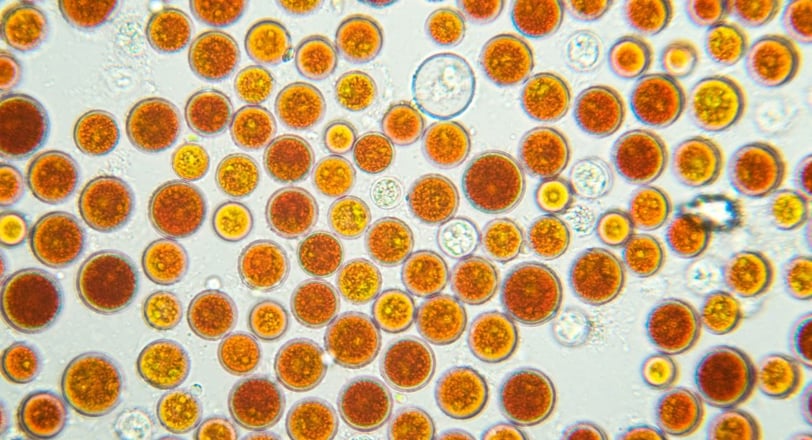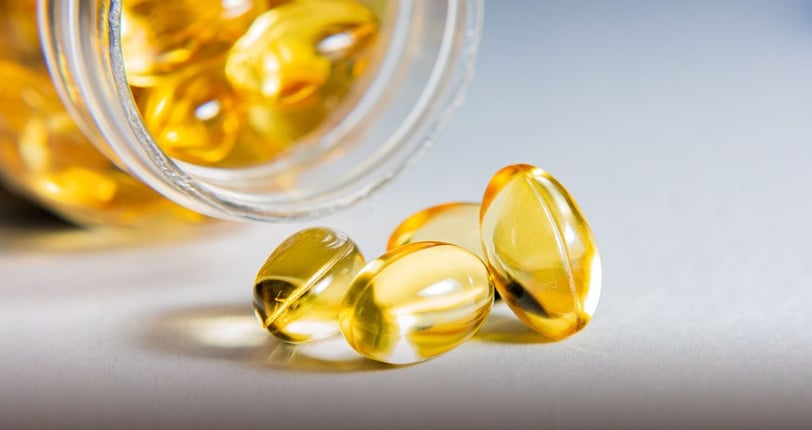Haematococcus: The Little Algae with Big Antioxidant Power
Discover Haematococcus pluvialis, the microalgae behind astaxanthin—nature’s most potent antioxidant—and how it boosts skin health, brain function, and longevity.


Haematococcus Pluvialis: From Survivalist Microbe to Wellness Superstar
In the sun-scorched rock pools of deserts and Arctic tundras, Haematococcus pluvialis thrives by producing astaxanthin, a crimson compound so powerful it protects the algae from UV radiation, drought, and starvation. This survival mechanism has made Haematococcus the richest natural source of astaxanthin, an antioxidant 6,000x stronger than vitamin C and 550x more potent than green tea catechins. Today, science reveals how this tiny algae can shield human cells from aging, inflammation, and environmental stressors, offering a sustainable path to holistic health.
This guide explores Haematococcus’s journey from ecological marvel to clinical powerhouse, blending cutting-edge research with practical applications.
The Algae’s Survival Saga – Evolution of a Super Antioxidant
Nature’s Extreme Survivor
Habitat: Thrives in ephemeral water bodies, enduring dehydration, UV exposure, and nutrient deprivation.
Astaxanthin Synthesis: Under stress, Haematococcus turns green → red, producing astaxanthin to protect its DNA and lipids.
From Lab Curiosity to Global Industry
1930s Discovery: German scientists identify astaxanthin’s role in algae survival.
2000s Breakthrough: Commercial cultivation begins in Israel and Hawaii using closed bioreactors for purity.
Today: A $1.2B industry fuels supplements, cosmetics, and aquaculture (e.g., salmon feed for vibrant flesh).
Astaxanthin’s Science – Why It Outshines Other Antioxidants
Molecular Mastery
Unique Structure: Crosses blood-brain and retinal barriers (unlike beta-carotene).
Bidirectional Action: Neutralizes free radicals in both cell membranes and aqueous environments.
Key Mechanisms
Mitochondrial Support: Enhances ATP production by 29%.
Nrf2 Pathway Activation: Boosts glutathione and SOD (superoxide dismutase) by 50%.
Inflammation Control: Lowers CRP (C-reactive protein) by 35%.
Evidence-Based Benefits
Skin Health & Anti-Aging
UV Protection: Reduces sunburn cell formation by 40%.
Collagen Boost: 25% reduction in wrinkles with 12-week oral use.
Brain & Eye Health
Cognitive Function: 20% faster memory recall in adults over 50.
Digital Eye Strain: 30% reduction in eye fatigue with 8 mg/day.
Athletic Performance
Endurance: Cyclists improved time-to-exhaustion by 15%.
Recovery: 22% lower muscle soreness post-workout.
Cardiovascular & Metabolic Support
LDL Oxidation: 33% reduction in plaque-forming lipids (Atherosclerosis, 2020).
Blood Sugar Balance: Enhances insulin sensitivity by 18% in prediabetics.
Using Haematococcus Safely and Sustainably
Forms & Dosage
Softgel Supplements: 4–12 mg astaxanthin daily (with fatty meals for absorption).
Topical Serums: 0.1–2% astaxanthin in skincare for UV defense.
Sustainability Note: Opt for brands using closed-loop bioreactors (e.g., Algatech, AstaReal).
Synergistic Pairings
With Omega-3s: Fish oil enhances astaxanthin bioavailability.
With Vitamin E: Amplifies antioxidant recycling.
Timing
Morning: Supports daytime UV/blue light protection.
Post-Workout: Reduces oxidative stress from exercise.
Debunking Myths
Myth 1: “All Astaxanthin Is the Same”
Reality: Synthetic astaxanthin (petroleum-derived) lacks Haematococcus’s natural co-factors (e.g., lipids, carotenoids).
Myth 2: “More Is Better”
Reality: Doses >12 mg/day show diminishing returns. Quality > quantity.
Practical Integration – Recipes & Routines
Astaxanthin Smoothie
Ingredients:
½ cup frozen blueberries
1 tbsp chia seeds
1 tsp spirulina
1 softgel Haematococcus oil (pierced)
1 cup coconut water
Benefits: Combats oxidative stress and boosts energy.
Skin-Protection Serum
DIY Blend: 5 drops astaxanthin oil + 1 tbsp rosehip oil. Apply nightly.
FAQs – Your Top Questions Answered
Q1: Is Haematococcus safe during pregnancy?
A: Limited data; consult a doctor. Natural astaxanthin in food (e.g., salmon) is safe.
Q2: Can it replace sunscreen?
A: No—use oral astaxanthin with SPF for layered UV defense.
Q3: How long until benefits appear?
A: 4–8 weeks for skin/cognitive effects; 2–3 weeks for exercise recovery.
Haematococcus – A Microalgae with Macro Impact
Beyond trendy superfoods, Haematococcus offers a science-backed, sustainable solution to modern oxidative stressors. By honoring its natural origins and pairing it with mindful habits, we harness an ancient survival strategy for 21st-century vitality.
Final Tip: Verify third-party certifications (USDA Organic, Non-GMO Project) to avoid synthetic imitations.
Review of Herbal medicines containing Haematococcus
References:
Haematococcus pluvialis as a Potential Source of Astaxanthin with Diverse Applications in Industrial Sectors: Current Research and Future Directions - https://pmc.ncbi.nlm.nih.gov/articles/PMC8587866/
Astaxanthin From Haematococcus pluvialis Prevents High-Fat Diet-Induced Hepatic Steatosis and Oxidative Stress in Mice by Gut-Liver Axis Modulating Properties - https://pmc.ncbi.nlm.nih.gov/articles/PMC9039660/


Products Reviews
Disclaimer
The statements on this website have not been evaluated by the Food and Drug Administration. The articles and products advertised are not intended to diagnose, treat, cure, or prevent any disease.
The content of the website and the products advertised are based on the opinions of the authors and are provided solely on an "AS IS" and "AS AVAILABLE" basis. You should do your own research and confirm information with other sources when seeking information about health issues, and always carefully review the information with your healthcare professional before using any of the protocols presented on this website and/or the products indicated. Neither Drops&Pills nor the authors are engaged in rendering medical or similar professional services or advice through this website or the products, and the information provided is not intended to replace medical advice offered by a physician or other licensed healthcare professional. You should not construe the recommendation of the products by Drops&Pills as an endorsement by Drops&Pills of the opinions expressed herein, or any guarantee of any strategy, recommendation, treatment, action, or application of advice made by the authors of the products.
Some names and personally identifiable information on this site have been changed to protect the privacy of individuals.
Drops&Pills is the publisher of the articles on this site. Drops&Pills' role as publisher does not constitute an endorsement, approval or review of the products advertised herein or any claim, statement or opinion used in the promotion of those products.
For product support, please contact the suppliers.
For purchase and order support, please contact the platform you placed the order through.
For support with article information, please contact Drops&Pills here.
*Free shipping according to the rules on the product page.
Natural Products for Better Health
© Drops&Pills Research 2025 All rights reserved
Contacts
contact@dropsandpills.com
